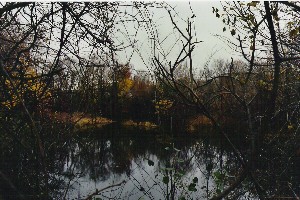|
Report
on Sawin's
and Williams Ponds
By Brian J. Le Blanc, November
5, 2003
Before
I begin, I wanted to
take this opportunity to thank those who spoke to me about Sawin's Pond
and
shared their insights and information, including Bruce Roberts, Susan
Falkoff,
Daphne Collins, Joe Di Vico, Diana Proctor, Angie Kounelis, and John
Airasian. I
also wanted to thank the Watertown Main Public Library, and the
Conservation
Commission for granting me both access to their files and allowing me
to speak
here tonight.
I came here tonight because I want to see Sawin's
and
Williams Ponds
cleaned up, but before we can clean them, we must understand how it
happened.
Sawin's
and
Williams Ponds are
parts of a brook that runs through East Watertown. In this 1853 map
(Fig. 1),
you can see the body of water in closest to its most natural form. It
starts as
a forked brook to the south of Mt. Auburn St. and west of the Old
Burying Ground
near present- day Porter St. From there, it flowed easterly until it
crossed
under the newly built railroad tracks, down underneath Arlington St,
and finally
into the Charles River.
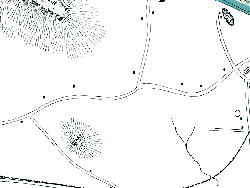
|
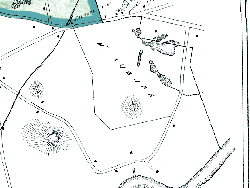
|

|
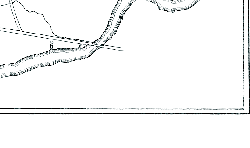
|
Figure
1: Plan
of Watertown 1853
Image
consisting of four quadaents, click for larger image.
|
|
In the late 1800s, three
people decided to seek their
fortunes by
developing land around the brook, one man with an eye to utilize the
natural
beauty of the area, and two brothers who wanted to take advantage of
the
confluence of a railroad line and a water supply.
George
W. Sawin was, in the late 1870s, the proprietor of
the Union
Market Hotel, which was on Walnut St. near the Union Market train
station. It
was a successful hotel, but Sawin had bigger plans. On November1st,
1878, he
purchased a tract of land between Arlington and Coolidge St, which
contained a
small glen that the brook ran through, “ for the purpose of flowing
said
meadow and for the purpose of a fish pond and for cutting ice upon the
same…” ([Book 1502, Page 558], from Title to Sawin's and Williams
Ponds
3/22/1973). Sawin also purchased a pond that had been made between
1851 and
1880 from Josiah Williams on July 31, 1880.
Sawin constructed a dam at Coolidge St and flooded
the
glen, creating a
pond several times larger than the one he had purchased from Williams.
It was
the finishing touch of the resort that he had built to overlook the
pond. He
also constructed a new street, Glen Rd, which provided access from
Coolidge St.
The Glen Hotel held its grand opening on Thursday evening, September 1st,
1881.
An October 5, 1881, article from the Watertown Enterprise
called “ A
Model Suburban Hotel, “ extols the virtues of Sawin’s new resort:
“For
healthfulness and
grandeur of scenery at all
seasons of the year, the location of this house cannot be excelled. On
the
premises is a beautiful pond, where the guests can enjoy a boat sail in
the
summer or skating in the winter. While on both sides of the pond are
beautiful
groves, well provided with swings, croquet grounds, bandstand, and all
the
etceteras of pleasure and pastime. “
In June 1882, a sting operation was conducted aimed at the
liquor dealers
of Watertown. State Officers employed three underage youths from Boston
as “ spotters “ to see who
would sell them alcohol. In all,
twenty
violations were handed out to the liquor dealers. The Glen Hotel was
one of the
alleged violators. According to the account of the “Liquor Trials”
published
in the June 28, 1882 edition of the Enterprise, “ The case of Sawin was
discharged because (“ spotter “ Thomas) Doorley testified that he
bought the
liquor of a barkeeper, Sawin being absent. The ruling of the Judge was
that a
dealer is not liable for the action of an agent, which may be contrary
to his
expressed of implied wishes. “
George W. Sawin may have won his court battle, but
lost a
great deal of
face in the eyes of Watertown society. His reputation, and that of his
“ model
suburban hotel, “ was besmirched, and it soon became known in town
legend as a
house of ill repute. He renamed the hotel several times, but the
business was
never as it was for that short wonderful period. In 1883, he sold part
of the
land to Harvey, including use of the pond, but retained all rights to
cut ice.
By the early 1890s, it was no longer listed as a hotel in the Watertown
directories, only that Sawin lived at 45 Arlington St.
Frederic
C. and Arthur N. Hood, on the other hand, were brothers who had spent
several
years learning the rubber business by working in the factories. By
1896, the
Hood brothers, now full of ideas, were ready to start their own
business. They
bought land bordered on the north by Nichols Ave and on the south by
the
railroad. The brook ran diagonally through the site, and was to provide
the
cooling water and power necessary to running a rubber factory.
The Hood Rubber Company opened in November, 1896.
Their
small operation
soon grew rapidly and they purchased the land on the other side of the
tracks
down to Arsenal St. Sometime between 1901 and 1905, Hood Rubber Company
bought
what were now called Williams Pond and Sawin's Pond from George W.
Sawin.
In all, the Hood Rubber Company at its height in the
early
1920s,
controlled over 80 acres of land, employed around 10, 000 people, and
produced
all manner of rubber products, including tires, boots and PF Flyers,
one of the
earliest sneakers. In 1929, the Hood Rubber Company was bought out by
the B.
F. Goodrich Corporation and renamed the B. F. Goodrich Footwear
Company, but
most people in Watertown continued to refer to it by its former name.
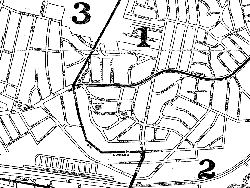
|
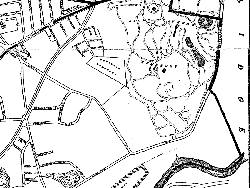
|

|

|
Figure
2: Map
of East Watertown
1925
Image
consisting of four quadrants, click for larger image.
|
|
The brook was harnessed for use within this massive
factory complex
mainly as coolant in the rubber treatment process. As the Hood plant
expanded,
the brook was culverted, built over, and incorporated into the storm
sewer
system of Watertown. For a time, the area that is now the front parking
lot of
the Watertown Mall was flooded and turned into a large industrial
lagoon called
Hoods Pond in 1907. Hoods Pond was shown on maps (see Figures 2 and 3)
until
around 1935
when it was filled in so the plant could expand further. The water that
the
plant needed was now pumped offsite from Sawin's and Williams Ponds and
returned
there through a series of culverts. The water, which had been subject
to
industrial processes, emptied out of Sawin's Pond and into the remnants
of the
brook which flowed alongside Arsenal St. to the Charles River.
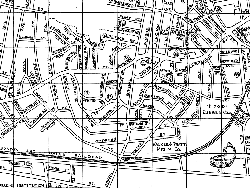
|
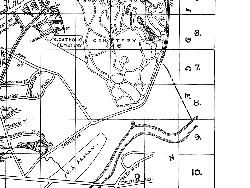
|
Figure
3: Map
of Watertown 1935
Image
consisting of two quadrants, click for larger image.
|
|
In the
1940s, the pond that Sawin had left behind was a
recreational
space for the people of the neighborhood. It was still fishable and
swimmable. Joe Di Vico, who moved to the area
with his family in 1932
from Italy
told me that the kids referred to the pond as the “ Sois, “ or the “
Soines. “ The area behind the ponds was still partially open land that
the
Italian immigrants farmed on land owned by the Town. The area where the
UPS
building is now was a wooded area that overlooked the pond where Army
soldiers
camped during World War II.
Joe Di Vico told me that by the 1950s, Sawin's Pond was no
longer
swimmable, and the Town told the immigrants that they could no longer
farm
there. The area had been zoned for industrial use. The dumps grew
larger, while
on the area along Glen Rd, which was now a private way, industrial
businesses
grew up on the former farmland. By the 1960s, Sawin's and Williams
Ponds were in
bad shape. The ponds had been encroached on all sides by industrial
businesses.
In 1965, the Hatch Act went into effect in Massachusetts, which forbade
the
alteration of any natural or man- made body of water without
authorization from
state and local government.
In the summer of 1966, the B. F. Goodrich Footwear Company
now had to
apply to the Massachusetts Department of Natural Resources, as well as
the
Watertown Planning Board, Board of Health, and Conservation Commission
to do
maintenance work at Sawin's Pond. They proposed six items, including
dredging
the pond. They wanted to continue to dump “ rubbish “ in the landfill
method
by building two dikes, decreasing the pond’s water capacity by filling
it with
trash. They also laid out a longer- term strategy of culverting
Williams Pond
for landfill. According to R. T. Wise, Superintendent of Engineering
and
Maintenance at B. F. Goodrich Footwear Company, “ (t)hese changes are
needed
so that essential industrial water supply and rubbish disposal can
continue in
the Sawin's Pond area. “ ( R. T. Wise letter to the Commissioner of the Massachusetts Department of Natural Resources
7/ 6/
66)
The Planning Board, Board of Health, and the Conservation
Commission all
agreed to part of the work scope. A June 29, 1966 letter from R. B.
Chase of the
Watertown Conservation Commission specifically approves two of the six
requests
of B. F. Goodrich: 1) to dredge Sawin's Pond and 2) to build a dike
along the
East side “and use the area between the fence and dike for landfill
rubbish
disposal.“
From
1966- 68, while B. F.
Goodrich was considering if staying in Watertown was part of their long
term
corporate strategy, they dumped a great deal of “ rubbish “ consisting
of
rubber scraps, some contaminated with solvents and plasticizers, with
approval
from town and state officials.
In December 1969, the B. F.
Goodrich Footwear Company closed
and moved operations to another plant in the Carolinas. It was said
that they
started to lose money in 1966. My great uncle, Patrick Callaghan, lost
his job
and his pension, as did 1,300 other workers.
Within the space of 4 years, over 130 acres of nearly
contiguous land,
formerly occupied by a U. S. Army munitions factory where they did
uranium and
nuclear testing, a rubber plant, two town dumps, and two polluted ponds
were
abandoned. A citizens panel, the Watertown Redevelopment Authority, was
formed
to purchase the Arsenal land and form a strategy of how to reintegrate
all of
this land back into East Watertown. Initially, ideas were put forth to
build a
“Mini- City” that incorporated both sides of Arsenal St. The B. F.
Goodrich
property, which included the ponds, was still owned by the company, and
they
were not all that interested in selling such lucrative property back to
the
town.
After B. F. Goodrich ceased operations, several local
businesses that
abutted Sawin's Pond installed illegal sewer hookups to drain into the
pond,
knocked down the fences to park trucks, and threw in all sorts of
garbage on top
of the unkempt piles of rubber waste. One business went so far as to
knock down
the fence to make a concrete ramp into Sawin's Pond so they could throw
broken
concrete burial vaults.
By 1973, the Berkeley and Clarendon Streets neighborhood,
which was next
to the ponds as well, had enough and lobbied the East Watertown
Betterment
Association to ask the Conservation Commission to fix this situation.
B. F.
Goodrich, who was trying to sell the property, removed excess rubbish,
brought
in fill to grade the banks, seeded it, and repaired the fence. The work
was
completed mere days before the sale of the property which was sold to
Wasserman
Development Corporation in the summer of 1973.
Max
Wasserman was sympathetic
to how Goodrich had mistreated both Watertown and the ponds. In March
1974, he
offered to sell Sawin's Pond to the town for $1.00 if they would allow
him to
culvert Williams Pond. Churchill indicated that the Town wanted to
preserve them
both. Wasserman resold the entire property to Campanelli Brothers and
their
partners, Corporate Property Investors, in December 1974.
From 1975- 83, Sawin's and Williams Ponds, fenced in and
overgrowth obscuring them from view, had a brief respite to begin
repairing
themselves.
The respite ended on January 29- 30, 1983, when 1000
gallons of PCBs from
a broken electric transformer spilled into a catch basin located at the
Boston
Edison building, which was built on the site of the original Hood
factory. The
PCBs went through the culverted brook and into the ponds. The
Environmental
Protection Agency and the Massachusetts Department of Environmental
Quality
Engineering were alerted to the spill. Eric Campanelli decided now was
the time
to finally offer to give the ponds to Watertown. The Town Council,
fearful of
having not only to pay for the ponds but have to clean them as well,
voted down
the proposal.
In April
1984, two brothers, Maximos Hatziiliades and Savvas
Iliades, owners of Western Roofing Company, purchased the property from
the
Campanellis. They proposed to build a parking lot in between the pond
next to
their commercial property on Arlington St. The Conservation Commission
was
determined to protect Sawin's and Williams Ponds from further
encroachment
because they are wetlands that are part of the natural drainage system
of East
Watertown.
The
Commission rejected the
Hatziiliades’ parking lot proposal, saying that they could not build
within
the 100’ buffer zone mandated around all wetland areas by the Wetlands
Protection Act. The Hatziiliades’ appealed and the Massachusetts DEQE
overruled the Commission’ s decision. This was merely the first
skirmish in a
prolonged litigation battle over the fate of Sawin's and Williams
Ponds.
Therein
lies the story of Sawin's
and Williams Ponds up to the present: they were artificially created
out of a
natural brook, polluted by industry, and left for others to clean up.
Despite
the fact that the Hatziiliades’ had not polluted their property but had
merely
purchased it in that condition, they are, under environmental law, are
responsible for cleaning it up.
In
March 1985, as a result of
the 1983 PCB spill, Sawin's and Williams Ponds were placed on CIRCLIS,
an EPA
database of potential controlled hazardous waste sites. The
Hatzilliades’
retained the services of Certified Engineering and Testing Co. to
determine the
causes and extent of the pollution. On April 29, 1985, Maximos
Hatziiliades was
served with a cease and desist order from the DEQE for “ intentionally
breaking the dike “ at Sawin's Pond, which lowered the water levels and
compromised the wetland.
It is this move that truly turned the Conservation
Commission’ s
attention to Maximos Hatzilliades. From this point on, the parking lot
proposal
and anything they wanted to do around the ponds was heavily
scrutinized. In
1986, the Commission denied the parking lot proposal again and
initially denied
a request to bore testing holes for soil and water samples, even though
they
were being conducted with the approval of the DEQE.
In
1987, the Commission passed
the Watertown Wetlands Ordinance, which prohibited building within 150’
of a
wetland. The Commission also handed out numerous citations to
Hatziiliades for
violations such as dumping into the ponds, leaving the gates open, and
parking
trucks next to them.
By
1989, Certified Testing and
Engineering had completed their initial assessment of Sawin's and
Williams Ponds
by looking at the site history and conducting water and soil samples.
They
discovered that the pond was created as a source of ice, and that Hood/
B.F.
Goodrich had polluted it over a number of years. They concluded that
although
the rubber scraps may be contaminating the groundwater, it was better
to leave
them buried, and that the source of much of the water pollution was the
runoff
from the town drainage system. They also recommended that the Town help
by
installing particle separators in
the storm drains.
In
1990, Hatziiliades
submitted a waiver application to the DEQE that would allow him, as the
owner of
the site, to remediate it without oversight, and was approved. This
means that
the DEQE and the EPA saw that the ponds were polluted but they did not
pose
enough of a threat to public safety to have to clean them
immediately.
The
Conservation Commission
did, however get the DEQE to make the ponds a Public Involvement Plan
site.
Hatziiliades had to prepare a report about the condition of the ponds
and their
plans for remediation, and file a copy of it at the Watertown Public
Library. In
the Sawin's and Williams Ponds Disposal Plan dated November 16,
1990, it
states that “ a portion of the site is proposed for development of
commercial
buildings and a park, “ and that “Maximos
Hatziiliades, property owner is prepared to pay the estimated $45,000
cost
incurred from the proposed remediation action.“ The Commission issued a
rebuttal disputing most of Certified’ s findings.
In1990 Hatziiliades applied for a third time to build the
parking lot. He
was denied once more, appealed, and received a hearing in front of
Administrative Judge Francis X. Nee. In June 1994, the Department of
Environmental Protection (formerly the Dept. of Environmental Quality
Engineering) found in favor of Hatzilliades’ proposal to build a
parking lot.
The Commission argued that Maximos Hatziiliades’ past actions showed
that he
“ could not be trusted, “ but Nee ruled that they had “not established
a
nexus between the applicant’s record and the issue, “ and concluded
that “
the Applicant’s record is not relevant to the issue.“
In
the fall of 1997,
Hatziiliades’ decision to not pay his property taxes in protest of his
treatment came back to haunt him when Watertown seized Sawin's and
Williams
Ponds as payment. Hatziiliades appealed this decision to the
Massachusetts Land
Court, but the Commission was hoping to have the Town get the ponds in
order to
settle his tax debt.
In
October 1998, the DEP
overruled the Commission’s decision in favor of Hatziiliades. After the
decision, Hatziiliades paid $21, 000 in back taxes, and the Land Court
ultimately gave ownership over his property back to him.
Hatziiliades
no longer needed
a parking lot for his business, but he found a new partner in the
neighborhood.
A popular gym called Super Fitness had opened next to Williams Pond but
it had
no parking lot, creating a traffic mess on Arlington St. Super Fitness
agreed to
lease the parking lot, and the Town finally allowed work to begin on
the parking
lot on February 8, 2000. Eighteen years after it was proposed, the
parking lot
was built and was completed in the fall of 2002.
The completion of the parking lot meant something quite
different to both
parties. For Maximos Hatziiliades, it represented a long- fought
victory. For
the Conservation Commission and their supporters, it was a disgraceful
end to a
long struggle to preserve encroachment upon the last remaining wetlands
in East
Watertown. Although I do not have a first- hand perspective on these
events, and
am merely writing the first historical account of it, I believe that
the
Commission fought so hard against Maximos Hatziiliades because many of
them
remember Sawin's Pond in all its glory. They had watched while it was
almost
destroyed and left for us to clean up. The Watertown Conservation
Commission
made sure that both Sawin's and Williams Ponds were saved from
destruction and
polluted as little as possible. They were enforcing laws that are
designed to
protect the land over the intentions of the landowner.
In the end, both sides got so caught up in the struggle
over the building
of a parking lot that they seem to have forgotten that Sawin's and
Williams
Ponds are still not clean, and have been hidden from public view for so
long
that most people in Watertown are unaware of their existence.
Several
people I have spoken
to who support the Conservation Commission's efforts think that the
only
solution is to have Watertown somehow seize the land, and even that was
tried
and did not work. Maximos Hatziiliades has asserted in the courts his
right to
develop within reason on his own property. This stalemate could
continue
indefinitely, but is it still possible for both groups to work together
to
improve the property? Would the Conservation Commission be willing to
allow
Maximos Hatziiliades to redevelop his property into something that
would
overlook and incorporate a remediated Sawin's Pond? We need to come to
a
reasonable compromise.
It
is the twenty- first
century, and East Watertown is a very different place. Where there were
once
factories, there are malls and office parks, and very little
undeveloped land.
The railroad tracks, except for a small spur from Fresh Pond down to
Grove St,
lie abandoned. I began to see a path that connected the potential open
space in
East Watertown. If you look at the map of my open space proposal the
walkway
starts at School St and follows the railroad tracks, going behind the
Watertown
Mall to Elm St. and Williams Pond, then to Sawin's Pond, alongside
Sawin's Pond
Brook, down along the GSA Site and up to Grove St to Fillippello
Park.
This
is the last part of the
redevelopment of East Watertown- the remaining land has to be preserved
as open
space. If we could just remediate Sawin's and Williams Ponds, it would
be the
start of a much larger project.
A
plan needs to be developed
that results in the clean up of Sawin's and Williams Ponds. Doing this
can be
the cornerstone of an open space master plan that unites the ponds,
brook, and
marsh into a whole once more, as a symbol of the final phase of the
redevelopment that began over 35 years ago.
By
doing so we could create a
walkway not unlike the Emerald Necklace. Think of the aesthetic and
economic
benefits that such a walkway could bring to East Watertown. It may take
a long
time, but if anything is going to happen we need to have a catalyst.
Perhaps the
Conservation Commission could take the initiative and attempt to make
peace with
Maximos Hatziiliades in order to begin the cleaning of Sawin's and
Williams
Ponds.
Thank
you.
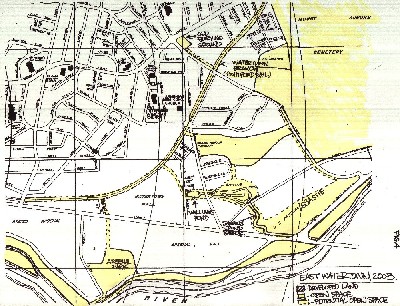
Figure 4: Open Space
Plan
click on the above image for the full
size
version.
|
Maps courtesy of the
Watertown Public Library, Historical Map Collection.
Questions, comments? Contact Brian at brianleblanc AT athenaverse.com
|

